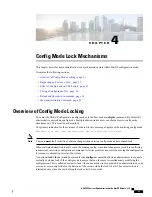
CISCO-PROCESS-MIB : Disabled
CISCO-ENTITY-FRU-CONTROL-MIB : Disabled
Step 2
Verify that the SNMP community(ies) were configured properly by entering the following command:
show snmp communities
The output of this command lists the configured SNMP communities and their corresponding access levels.
Step 3
Verify that the SNMP transports are configured properly by entering the following command:
show snmp transports
The following displays a sample output:
Target Name:
rms1
IP Address:
192.168.1.200
Port:
162
Default:
Default
Security Name: public
Version:
1
Security:
View:
Notif Type:
traps
Controlling SNMP Trap Generation
The system uses SNMP traps (notifications) to indicate that certain events have occurred. By default, the
system enables the generation of all traps. However, you can disable individual traps to allow only traps of a
certain type or alarm level to be generated. This section provides instructions for disabling/enabling SNMP
traps.
Commands used in the configuration samples in this section provide base functionality. The most common
commands and keyword options are presented. In many cases, other optional commands and keyword
options are available. Refer to the
Command Line Interface Reference
for complete information regarding
all commands.
Important
To configure SNMP trap generation:
Step 1
Set parameters by applying the following example configuration:
configure
snmp trap suppress
snmp trap suppress trap_name1 trap_name2
...
trap_nameN
If at a later time you wish to re-enable a trap that was previously suppressed, use the
snmp trap enable
command.
Step 2
Save the configuration as described in
Verifying and Saving Your Configuration
.
ASR 5500 System Administration Guide, StarOS Release 21.5
64
Management Settings
Controlling SNMP Trap Generation






























